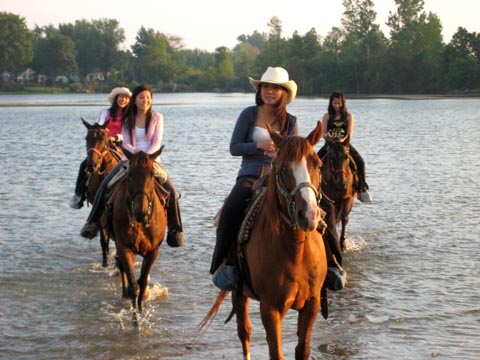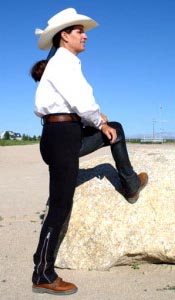
Trainer Julie Goodnight had a good article in the April 2009 issue of Horse & Rider magazine that is worth reblogging.
Question:
I mostly enjoy trail riding on my 8-year-old Half-Arabian gelding. He has a great disposition and is calm and focused in the arena, but when I’m out on the trail, he gets antsy. He starts to jig, tries to race in front of the other horses, and feels like he’s about to take off. Not only is this annoying, but I’m beginning to fear for my safety. Is there anything I can do to stop his behavior? – Lynn Yates, Ohio
 Answer:
Answer:
Lynn, it’s quite understandable that you feel anxious about your gelding’s behavior, and I can see why it detracts from your enjoyment of trail riding. Whether you’re contributing to your horse’s anxiety or it’s mostly his idea, you need to quickly correct this misbehavior before it becomes a bigger problem. Here, I’m going explain why your horse might be engaging in this behavior. Then, I’ll give you a fix for while you’re on the trail, as well as some homework to do in the arena.
Why The Jig?
You’re the problem. Next time you’re on the trail, evaluate your position and body language. Did you find yourself tensing up, gripping the reins, or perching forward in the saddle in anticipation of your horse’s misbehavior? If so, you’re inadvertently contributing to his anxiety. He feels you tighten up as if something big is about to happen, and subsequently follows your cue.
Disobedience.
Your horse may simply be misbehaving. If you allow him to get away with other misbehaviors, such as fidgeting while you’re mounting, moving forward without your cueing, breaking gait at his bidding, then he’s learned whatever he decides goes. If he wants to jig on the trail, he’s going to–even if you say “no.”
The Fix
No matter the root of your horse’s jigging, the following solutions can be applied to correct his behavior and help make your next trail ride more enjoyable.
Basic management.
Especially if your horse is stalled, offer him plenty of turnout time. Providing him with the opportunity to move at liberty will help keep excessive pep to a minimum. Or, if you’re only riding him once a week on the trail, try to incorporate more exercise into his routine. This can include longeing, hand-walking, riding in an arena–or on the trail. And, make sure he’s on a reasonable diet. If he’s getting a large grain ration, it could be giving him excessive energy. If you’re uncertain about how much (or what) to feed him, consult your vet for advice. You may find that a diet lower in sugar and starch settles him and helps him focus more on you when you’re riding.
Action on the trail.
Once you’re mounted, take a slow, deep breath; sit up tall and slightly back on the pockets of your jeans; relax your muscles; and keep your reins loose. Then, allow your horse to make a mistake. The instant he begins to jig, abruptly pull up and back on your reins (it’s OK to pull a little harder here than you normally would to make an impression), while saying “whoa” and exhaling, sitting back and relaxing your lower legs so they’re completely off his sides.
The moment he goes back to a walk, dramatically release your reins to give him his head and neck, and gently place your knuckles on his neck in front of your saddle. That comforting touch, along with a loosened rein, is his reward that says, “Yes, a walk is what I want.” Timing is key. The quicker you correct your horse once he begins to jig, the faster he’ll learn that the correct behavior (walking) results in the reward.
As he walks, relax, sit slightly back and concentrate on the feel of your horse’s walk. Notice how your hips move with the four-beat rhythm of his walk. Any time you successfully bring your horse back to a walk from a jig, assume this position to encourage the walk as the easiest and most natural response to your cues. The first few times you execute this stop-and-walk action, you may only get a few walking steps. That’s OK. Consider those few steps a success, and take comfort that he’ll learn with time and repetition.
Homework.
Doing regular, quality work in the arena can greatly expedite your progress on the trail. (For safety purposes, always work in an enclosed area with good footing and safe fencing).
Give your horse directives the moment you’re in his presence and insist that he comply to remind him that you’re in charge.
Insist that he stand perfectly still while you mount. Don’t allow him to walk off the moment your feet are in the stirrups; make him wait until you cue him forward. Once mounted, immediately set him to work by directing him to the rail. Make circles, change directions, insist that he go all the way into the corners of the arena. He should quickly and willingly move forward into a walk, jog or lope when you cue him, and only break gait when you ask.
Don’t compromise. The sooner you convey–or remind–him who’s boss, the better you’re going to get along and the more fun you’ll have on the trail.

This advice from Julie Goodnight is excellent, but I would add to it by saying that the most important thing for your trail horse to learn is to stand. If you’ve been using words like “ho” or “whoa” but allowing him to move his front hooves after that, change the word to “stand”. That is a new sound for him and he can learn it means to keep front hooves stationary until a different cue or word-command is given. Once he learns the meaning of “stand” and you are on the trail following Goodnight’s advice about how to keep your horse from jigging, use your word “stand” followed by several backing steps and another stand. (hopefully you’ve taught him to back) The way this works is that a horse is intelligent enough to figure out that he is losing ground and will soon learn to walk as you wish in order not to lose ground. Remember to vary the time periods of the stands and the number of steps backwards to prevent your horse from anticipating. For more details about this kind of training find Basic Training for a Safe Trail Horse, which is a small paperback available at Amazon for less than $10.